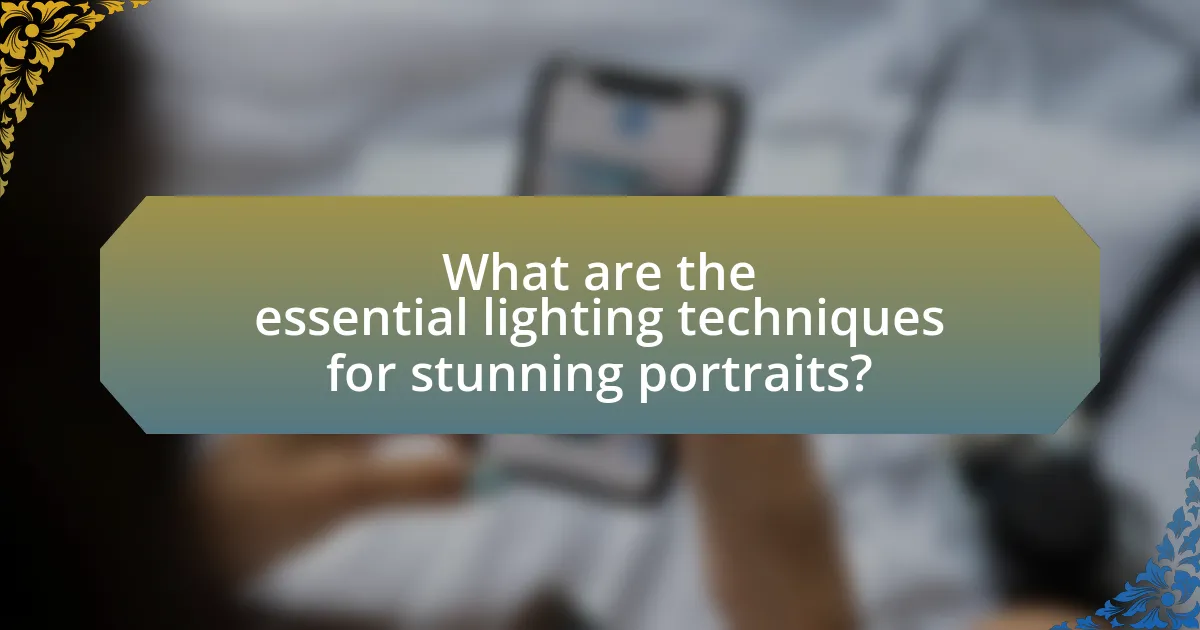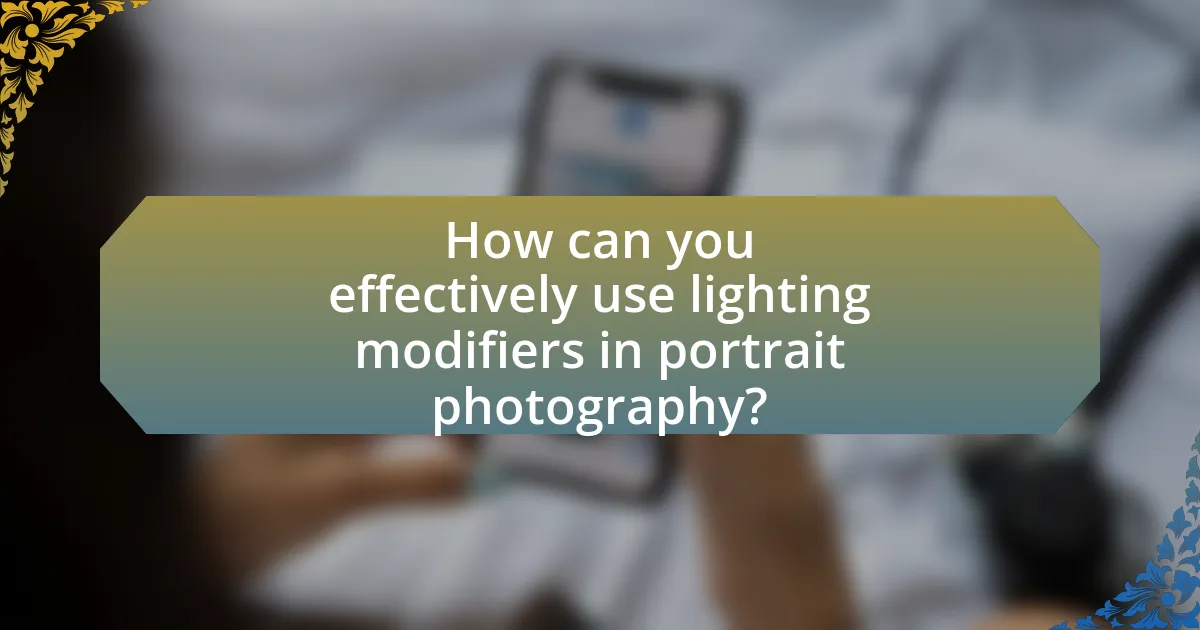The article focuses on essential lighting techniques for achieving stunning portraits, emphasizing the importance of both natural and artificial lighting. Key techniques discussed include natural light during golden hour, softbox lighting for even illumination, and Rembrandt lighting for depth. The article also explores the impact of light direction, quality, and modifiers such as reflectors and gels on portrait aesthetics. Additionally, advanced techniques like butterfly and split lighting are covered, along with practical tips for avoiding common lighting mistakes and enhancing portrait photography skills.

What are the essential lighting techniques for stunning portraits?
The essential lighting techniques for stunning portraits include natural light, softbox lighting, and Rembrandt lighting. Natural light, often used during golden hour, creates a flattering and warm effect on skin tones. Softbox lighting diffuses harsh light, reducing shadows and providing even illumination, which is crucial for highlighting facial features. Rembrandt lighting, characterized by a triangle of light on the cheek opposite the light source, adds depth and dimension to the subject’s face. These techniques are widely recognized in portrait photography for their ability to enhance the subject’s appearance and create visually appealing images.
How does natural light influence portrait photography?
Natural light significantly influences portrait photography by affecting the mood, tone, and clarity of the images. The quality of natural light, such as its direction, intensity, and color temperature, can create soft shadows and highlights that enhance facial features, making subjects appear more three-dimensional. For instance, during the golden hour, which occurs shortly after sunrise or before sunset, the warm, diffused light can produce flattering skin tones and a pleasing atmosphere, as supported by numerous photographers who emphasize this time for optimal results.
What are the best times of day for natural lighting?
The best times of day for natural lighting are during the golden hour, which occurs shortly after sunrise and before sunset. During these times, the sunlight is softer and warmer, creating flattering conditions for portraits. Research indicates that the angle of the sun during these periods reduces harsh shadows and enhances skin tones, making it ideal for photography.
How can you manipulate natural light for better results?
To manipulate natural light for better results, photographers can use reflectors, diffusers, and strategic positioning. Reflectors bounce light onto the subject, enhancing illumination and reducing shadows, while diffusers soften harsh sunlight, creating a more flattering effect. Positioning the subject in relation to the light source, such as using backlighting or side lighting, can also dramatically alter the mood and depth of the portrait. Studies show that utilizing these techniques can improve the quality of light in photography, leading to more visually appealing images.
What role does artificial lighting play in portrait photography?
Artificial lighting is crucial in portrait photography as it allows photographers to control the quality, direction, and intensity of light, enhancing the subject’s features and creating mood. By using artificial light sources such as strobes or continuous lights, photographers can achieve desired effects like soft shadows or dramatic highlights, which are essential for emphasizing facial contours and textures. Studies show that proper lighting can significantly impact the emotional response of viewers, making it a vital element in portrait composition.
What types of artificial lights are commonly used?
Common types of artificial lights used in photography include continuous lights, flash units, and LED lights. Continuous lights provide a constant source of illumination, making it easier for photographers to see how the light affects the subject in real-time. Flash units, such as speedlights and studio strobes, emit a brief burst of light, allowing for high-speed photography and the ability to freeze motion. LED lights are versatile and energy-efficient, offering adjustable color temperatures and brightness levels, which are beneficial for achieving desired effects in portrait photography. These lighting types are widely utilized due to their effectiveness in enhancing image quality and controlling shadows and highlights.
How can you create a soft light effect with artificial sources?
To create a soft light effect with artificial sources, use diffusers or softboxes to scatter the light. These tools reduce harsh shadows and create an even illumination on the subject. For instance, a softbox can be placed in front of a flash or continuous light source, which helps to mimic the natural softness of daylight. Additionally, positioning the light source further away from the subject can also contribute to a softer effect, as the light becomes less intense and more diffused. This technique is widely used in portrait photography to enhance the subject’s features without creating unflattering shadows.
What are the key principles of lighting in portrait photography?
The key principles of lighting in portrait photography include direction, quality, color, and intensity. Direction refers to the angle from which light hits the subject, affecting shadows and highlights; for instance, front lighting minimizes shadows, while side lighting creates depth. Quality pertains to the softness or hardness of light, with soft light producing flattering results and hard light emphasizing texture. Color involves the temperature of the light, which can influence the mood of the portrait; for example, warm light can evoke a sense of comfort. Intensity relates to the brightness of the light, which can be adjusted to achieve the desired exposure and effect. These principles are foundational in creating compelling and visually appealing portraits.
How does the direction of light affect the subject?
The direction of light significantly affects the subject by altering the perception of depth, texture, and mood in portrait photography. When light comes from the front, it minimizes shadows and creates a flat appearance, which can be unflattering. Conversely, side lighting enhances texture and dimension, revealing contours and details, while backlighting can create silhouettes or a halo effect, adding drama. Studies in photography demonstrate that the angle of light influences how features are highlighted or obscured, impacting the overall aesthetic and emotional response of the viewer.
What is the importance of light quality in portraits?
Light quality is crucial in portraits as it directly influences the mood, texture, and overall aesthetic of the image. High-quality light, characterized by softness and evenness, enhances skin tones and reduces harsh shadows, resulting in a more flattering representation of the subject. Conversely, poor light quality can create unappealing contrasts and distort features, detracting from the portrait’s effectiveness. Studies in photography emphasize that diffused light sources, such as softboxes or natural light on overcast days, yield more pleasing results by minimizing imperfections and highlighting the subject’s best attributes.

How can you effectively use lighting modifiers in portrait photography?
To effectively use lighting modifiers in portrait photography, select the appropriate modifier based on the desired effect, such as softboxes for soft light or reflectors for fill light. Softboxes diffuse light, reducing harsh shadows and creating a flattering look on the subject’s face, while reflectors bounce light back onto the subject, enhancing highlights and reducing contrast. Research indicates that using modifiers can improve the quality of light, making portraits more visually appealing and professional. For instance, a study by the American Society of Photographers highlights that portraits lit with softboxes are perceived as more flattering by viewers compared to those lit with direct flash.
What are the different types of lighting modifiers available?
The different types of lighting modifiers available include softboxes, umbrellas, reflectors, grids, and snoots. Softboxes diffuse light, creating a soft and even illumination, which is ideal for portraits. Umbrellas can either reflect or diffuse light, providing versatility in lighting setups. Reflectors bounce light back onto the subject, enhancing highlights and reducing shadows. Grids control the spread of light, allowing for more focused illumination, while snoots create a narrow beam of light for dramatic effects. Each modifier serves a specific purpose in shaping and controlling light, making them essential tools for photographers.
How do softboxes enhance portrait lighting?
Softboxes enhance portrait lighting by diffusing light, which creates a softer and more even illumination on the subject’s face. This diffusion reduces harsh shadows and minimizes the appearance of blemishes, resulting in a more flattering and natural look. The design of softboxes, which typically includes a reflective interior and a translucent front, allows for controlled light spread, making it easier to achieve the desired lighting effect. Studies in photography have shown that softer light sources, like those produced by softboxes, are preferred in portrait photography for their ability to enhance skin tones and provide a more aesthetically pleasing result.
What is the impact of reflectors on lighting quality?
Reflectors significantly enhance lighting quality by redirecting and diffusing light, which creates a more balanced and flattering illumination on subjects. They can soften shadows, reduce harsh contrasts, and improve the overall aesthetic of the lighting in portrait photography. For instance, using a white reflector can increase the light on a subject’s face by up to 50%, while a silver reflector can produce a more intense light effect, making the subject appear more vibrant. This manipulation of light through reflectors is crucial in achieving professional-looking portraits, as it allows photographers to control the mood and depth of the image effectively.
How can you use gels and filters to enhance portrait lighting?
Gels and filters can enhance portrait lighting by modifying the color temperature and controlling the intensity of light. Gels, which are colored transparent materials, can be placed over lights to create specific color casts, allowing photographers to achieve desired moods or effects, such as warm skin tones or dramatic shadows. Filters, on the other hand, can be used on camera lenses to reduce glare, enhance contrast, or soften the overall image. For instance, a polarizing filter can minimize reflections and increase saturation, making colors appear more vibrant in portraits. These techniques are widely used in professional photography to create visually appealing images that resonate with viewers.
What colors of gels are most effective for skin tones?
The most effective colors of gels for skin tones are typically warm tones such as amber, orange, and gold. These colors enhance the natural warmth of the skin, creating a flattering and vibrant appearance in portrait photography. Research indicates that warm gels can reduce the harshness of lighting and improve skin tone representation, making subjects appear more lifelike and appealing.
How do filters change the mood of a portrait?
Filters change the mood of a portrait by altering the color balance, contrast, and overall tone of the image. For instance, warm filters can create a cozy and inviting atmosphere, while cool filters may evoke feelings of calmness or melancholy. Research indicates that color psychology plays a significant role in how viewers perceive emotions in images; for example, red tones can convey passion or intensity, while blue tones often suggest tranquility. Therefore, the choice of filter directly influences the emotional response elicited from the viewer, making it a powerful tool in portrait photography.

What are some advanced lighting techniques for professional portraits?
Advanced lighting techniques for professional portraits include Rembrandt lighting, butterfly lighting, and split lighting. Rembrandt lighting creates a triangle of light on the subject’s cheek, enhancing facial features and depth, often used in classic portraiture. Butterfly lighting, characterized by a shadow under the nose resembling a butterfly, is effective for beauty shots, highlighting cheekbones and creating a glamorous look. Split lighting, which illuminates one side of the face while leaving the other in shadow, adds drama and intensity, making it suitable for more moody portraits. These techniques are widely recognized in photography for their ability to shape and define the subject’s appearance, enhancing the overall impact of the portrait.
How can you achieve dramatic effects with lighting?
To achieve dramatic effects with lighting, utilize high contrast between light and shadow, which enhances depth and emphasizes features. Techniques such as using a single light source, positioning it at an angle, and employing modifiers like softboxes or grids can create striking shadows and highlights. For instance, Rembrandt lighting, characterized by a triangle of light on the cheek opposite the light source, is a classic method that adds drama and dimension to portraits. This approach is supported by the principles of chiaroscuro, a technique used in art to create a strong contrast between light and dark, effectively drawing attention to the subject’s facial features.
What is the technique of Rembrandt lighting?
Rembrandt lighting is a photographic technique characterized by a specific lighting pattern that creates a triangle of light on the subject’s cheek opposite the light source. This technique is named after the Dutch painter Rembrandt van Rijn, who often used this style in his portraits to enhance depth and dimension. The hallmark of Rembrandt lighting is the interplay of light and shadow, which adds a dramatic effect to the subject’s face, making it a popular choice among portrait photographers.
How does split lighting create depth in portraits?
Split lighting creates depth in portraits by illuminating one side of the subject’s face while leaving the other side in shadow. This contrast enhances facial features and contours, making the subject appear more three-dimensional. The stark division between light and shadow draws attention to the subject’s structure, emphasizing cheekbones and jawlines, which contributes to a more dynamic and engaging image. Studies in photography demonstrate that this technique effectively highlights textures and shapes, reinforcing the perception of depth in visual compositions.
What are the benefits of using multiple light sources?
Using multiple light sources enhances the quality and versatility of portrait lighting. This technique allows for better control over shadows and highlights, resulting in a more dimensional and visually appealing image. For instance, employing a key light, fill light, and backlight can create depth and separation from the background, which is crucial in portrait photography. Additionally, multiple light sources enable photographers to manipulate the mood and atmosphere of the shot, as different light placements can evoke various emotional responses. Studies in photography emphasize that balanced lighting from multiple sources reduces harsh shadows and creates a more flattering representation of the subject, thereby improving overall image quality.
How can you balance light from different sources effectively?
To balance light from different sources effectively, utilize a combination of light modifiers and metering techniques. Light modifiers, such as softboxes or reflectors, can diffuse or redirect light to create a more uniform illumination across the subject. Additionally, employing a light meter allows for precise measurement of the intensity of each light source, enabling adjustments to achieve a harmonious balance. For instance, using a light meter can help determine the optimal exposure settings when combining natural light with artificial lighting, ensuring that neither source overpowers the other. This approach is supported by the principles of exposure triangle in photography, which emphasizes the relationship between aperture, shutter speed, and ISO in achieving balanced lighting.
What techniques can be used to avoid harsh shadows?
To avoid harsh shadows, utilize soft lighting techniques such as diffusing light sources, employing reflectors, and adjusting the position of the light. Diffusing light can be achieved by using softboxes or sheer fabrics, which spread the light evenly and reduce intensity, thus minimizing shadows. Reflectors can bounce light back onto the subject, filling in shadows and creating a more balanced illumination. Additionally, positioning the light source at a greater distance or at a higher angle can help soften shadows, as the light will spread over a larger area. These methods are widely recognized in photography and lighting design for their effectiveness in creating flattering and even lighting conditions.
What practical tips can enhance your portrait lighting skills?
To enhance portrait lighting skills, utilize natural light effectively by positioning subjects near windows during golden hour for soft, flattering illumination. This technique leverages the warm tones and diffused quality of sunlight, which can significantly improve the aesthetic of portraits. Additionally, experiment with reflectors to bounce light onto the subject’s face, reducing harsh shadows and creating a more even light distribution. Using a diffuser can also soften direct light sources, preventing overexposure and enhancing skin tones. These methods are supported by photography principles that emphasize the importance of light quality and direction in achieving visually appealing portraits.
How can you practice lighting techniques at home?
To practice lighting techniques at home, set up a designated area with various light sources such as natural light from windows, lamps, or external flashes. Experiment with different angles and distances of the light sources to observe how they affect shadows and highlights on subjects. For instance, using a softbox or diffuser can create softer light, while direct light can produce sharper shadows. Additionally, utilizing reflectors can help bounce light onto the subject, enhancing the overall illumination. This hands-on experimentation allows for a practical understanding of lighting dynamics, which is essential for mastering portrait photography.
What common mistakes should you avoid in portrait lighting?
Common mistakes to avoid in portrait lighting include using harsh lighting, which can create unflattering shadows on the subject’s face. Additionally, failing to consider the direction of light can lead to uneven illumination, making the portrait appear flat. Overexposing or underexposing the image is another critical error, as it can result in loss of detail in highlights or shadows. Not using modifiers, such as softboxes or reflectors, can also lead to unrefined lighting that lacks depth. Lastly, neglecting the background lighting can distract from the subject, diminishing the overall impact of the portrait.















